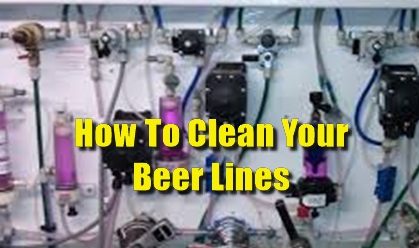We all hate having to do it, we all complain that it takes up too much time and we all reckon it costs us too much money … but if you don’t do it you’ll go out of business quicker than a snow-ball vendor in Hades. Beer-line cleaning and cellar maintenance are two of the fundamental principles of good pub management … yes they are a chore, yes they take up precious time and yes it does cost for the lost beer, water and chemicals … but if you have dirty beer-lines and foul-tasting warm beer then you will soon have an empty pub.
This guide will help you understand how to clean your beer-lines safely, effectively and efficiently; save time and minimise the cost to your business. I have always been of the mind-set that beer should be treated like any foodstuff in your kitchen (the law certainly classifies beer as a foodstuff anyway); as with food in the kitchen, you need to handle beer correctly and hygienically, store it in the correct conditions and keep the equipment and areas you store it in scrupulously clean – just as you do with your kitchen.
20 Step Beer Line Cleaning
Before You Start Safety Note: beer-line cleaner is hazardous to your health. You should always read and follow the instructions for its use (dilution and contact time), wear the correct protective equipment (goggles, rubberised apron / gloves) and know what to do about spills and splashes before you start using it.
The use of beer-line cleaner should form part of your COSHH policy.
- The first point of contact between your beer and your customer is the keg coupler and the wall mounted cleaning socket and you need to keep both clean. When you start the beer-line cleaning process the first thing to do is immerse the coupler in a bucket of warm water with beer-line cleaning solution diluted at the proportion and clean it thoroughly (and the socket too).
- Once cleaned attach all the keg couplers to their respective sockets and turn off the gas to each line. (Sockets, whilst providing a pretty good liquid seal, sometimes leak gas.) Turn on the gas to the cleaning system, this will push the cleaning fluid solution through the “ring main” and on to the individual fonts on your bar.
- Turn off any “flash coolers” and the remote cooling system in the cellar – this will prevent any chance of cleaning fluid solution or flush water freezing in the lines. And why waste energy and money cooling cleaning fluid solution or flush water? (Turn off the blowers and cellar cooling whilst you are beer line cleaning, the constant to and fro and with doors open will make it work over-time, the cellar will cool back down quickly enough when you’ve finished.) Every penny counts!
- Wash out the cleaning container (having emptied it of any liquid left over from the last time you cleaned the lines – Tsk! Tsk!). Fill the container to the level indicated on the container.
- Set all the cellar buoys to their respective cleaning positions and bleed off any gas.
- In the bar, remove all the diffusers and sparklers from the beer fonts and place in a bucket of water.
- Now flush all the lines of beer by running the cold water in the cleaning container through the taps, it will get rid of any accumulated debris and will minimise the amount of cleaning fluid solution you have to use to effectively clean the lines.
- Make up the correct dilution of cleaning fluid in the cleaning container in the cellar according to the instructions on the cleaning fluid you use for the size of cleaning container you are using. (Whether you are relying on staff to carry out beer line cleaning or doing it yourself, I would recommend that you choose a cleaning fluid with dye contained in it to ensure that all cleaning fluid is flushed out at the rinsing stage of the process.)
- You can now pull the cleaning solution through each line until all the water has been displaced. You will know when this has been achieved in one of two ways: if you are using a clear solution you can use a litmus paper strip that will change colour or you can feel the solution come through when it feels “slippery” when rubbed between your finger-tips. (The latter method isn’t really recommended, but sometimes you run out of litmus paper strips – if you do use this method make sure you wash your hands afterwards and avoid contact with your mouth or eyes.)
- Return to the cellar and bleed cleaning solution through the fob detectors to make sure they are cleaned too.
You’re half way through the process now …
Continue reading … page2 • page 3
